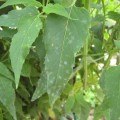Fungal disease that makes potatoes ugly. They can still be eaten, and it supposedly doesn’t reduce crop yield, but infected potatoes won’t store well. There are a few different forms of scab (Common Scab & Powdery Scab). There’s no treatment, but soil moisture & pH levels are ways to manage it.
Physical Description
Caused by soil-borne fungus, which flourish at neutral pH.
Species
- Common Scab: Streptomyces spp.
- russet scab: Streptomyces spp.
- pitted scab: Streptomyces spp.
- raised scab: Streptomyces spp.
- Powdery Scab: Spongospora subterranea
- patchy russetting (not really scab, but commonly confused as scab): Rhizoctonia solani
Mode of Transmission or Inoculation
- Infected seed tubers inoculate the soil
- the fungus persist in soil, living on decaying organic matter. I suppose soil that you bring in from other places could also contain the fungus.
- Tubers become susceptible to infection when they start forming. Scab lesions expand as the infected tubers grow.
- Mature tubers with well-developed skins are not susceptible.
- The fungus can also persist in non-composted manure from animals that have fed on infested tubers. When done properly, however, composting can apparently destroy infective inoculum of Streptomyces.
Plants Affected
- Potatoes
- these other crops don’t seem to be affected, but they act as a host to the fungus:
- beets
- radishes
- cabbages
- carrots
- spinach
- turnips
Plants Unaffected
Geographical Range
Common scab is widely distributed
Signs & Symptoms
Whole Plant
Stem
- brown stem lesions
Leaves
Flowers
Fruit
Roots/Tubers
Tuber symptoms of common scab vary in extent and appearance:
- Common scab
- lesions are usually circular and 0.25 to 0.33 inch (6 to 8 mm) in diameter,
- but they can be smaller in early stages of development and
- larger if they coalesce.
- Lesions typically possess a raised margin and slightly depressed center. Some characteristic symptoms have descriptive names:
- russet scab appears on tubers as superficial tan to brown corky lesions;
- pitted scab is characterized by lesions with depressions beneath the tuber surface; and
- raised scab appears as cushion-like, warty lesions.
- stolons can also develop scab lesions
- powdery scab ??
- patchy russetting ??
How to Positively Identify
physical symptoms of tubers
Treatment
???
Prevention & Control
Cultural Controls:
Soil pH
- relatively low soil pH (5.5) inhibits scab, but S. acidiscabes can cause scab in soils at less than pH 5.5
- acid scab (S. acidiscabes) can survive down to 5.2
- holding your soil pH too low affects the availability of several nutrients (see my article, Soil pH, for more info)
- When applied before planting, some soil amendments such as sulfur and triple superphosphate decrease soil pH, which makes the soil less favorable to disease development
Temperature
This fungus appreciates warm, dry soil; pay close attention to moisture levels if you are in a warm climate
Humidity or Soil Moisture Level
- Infection is favored by warm dry soils, so maintaining high soil moisture when the tubers are forming, until about 6-8 weeks later, can reduce the severity of scab infection, and control the infection adequately (high soil moisture is defined as 80-90% of the available water storage)
- it is believed that bacteria out-compete the fungus at these higher moisture levels
- this also means that the standard “well-draining soil” is bad in this case, since it dries out quicker
Mulching & Cultivation Practices:
- Disease severity is usually increased by continuous cropping to potatoes, so crop rotation is a must.
- rotating with green manure crops like alfalfa, corn, rye, millet and oats, help to reduce scab fungus (or other small grains)
- not advised: rotations with cabbage, carrots, beets, spinach, turnip, and radish
- avoid red clover. which “stimulates problems from common scab”
- Avoid soil application of animal wastes, which favors scab development.
- Use certified seed tubers free from common scab
- grow resistant varieties that are adapted to your area
- high levels of organic matter increase scab infection
Natural Enemies & Biological Controls
Insects:
Animals:
Reptiles:
Barriers
Traps
Sprays & Dusts
Sources:
- UC IPM: Common Scab
- Cornell University’s Vegetable MD: Potato Scab


